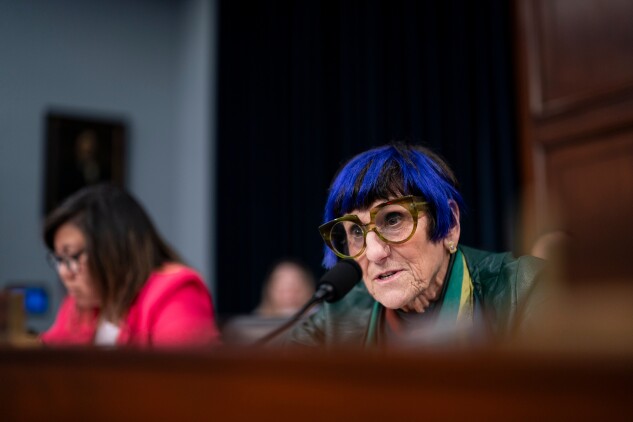- Partisan tensions, thin majorities risk spending discussions
- Just 11 session days remain before March 14 funding deadline
Congress is showing no signs of overcoming the partisan gridlock that could force a government shutdown in a month.
Current funding expires on March 14, and if Congress cannot agree on a spending deal, federal agencies will be forced to shut down. It could be the first significant shutdown in six years and would only add to the disruption across government amid President Donald Trump’s bid to eliminate and consolidate chunks of it.
Republicans’ razor-thin majorities, combined with a bruised relationship between the parties over President Donald Trump’s first weeks in power, have hampered any significant headway for finalizing funding for the final six months of the fiscal year. There are signs that Congress might only be able to fund the government at current levels for the rest of the year rather than negotiate new spending numbers.
House Appropriations Committee Chairman Tom Cole (R-Okla.) said negotiations are getting “closer” on new spending, but conceded leadership has given him signals they are looking at other options to keep the government’s doors open which could include a year-long stopgap, also known as a continuing resolution.
A number of Republicans have clamored for a year-long stopgap with half of the year already funded under the current CR. Cole, averse to stopgaps but more opposed to government shutdowns, hasn’t ruled out a stopgap but is deferring to leadership.
Speaker Mike Johnson (R-La.) didn’t rule out a year-long stopgap, saying Republicans “are looking at all options right now.” He pinned the blame on Democrats for “sending counter-offers that they know are not deliverable.”
While March 14 is a month away on the calendar, time is tight with the House only in session 11 of those days, Johnson said lawmakers “still have a lot of time left on the clock.”
A wild card in the talks is Trump, who could reject any agreement and insert his own demands, much as he did during spending negotiations in December when he suddenly announced that raising the debt limit should be part of a short term spending measure. Democrats and a number of Republicans loathe to raise the debt ceiling rebuffed him and Trump, not yet in office, was forced to accept the current spending extension that expires in March.
But appropriators think there’s still light left at the end of the tunnel. Senate Appropriations Committee Chair Susan Collins (R-Maine) said Tuesday that negotiators were “finally starting to make some progress.”
Congress narrowly dodged multiple shutdowns over the last two years with bipartisan spending bills. The last time federal funding lapsed, during Trump’s first term, political brinkmanship sparked a 35-day government shutdown: the longest in US history.
Lawmakers fear another lengthy shutdown, which would put non-essential federal employees temporarily out of work, while federally-owned entities like national parks would be shuttered. Federal workers, including congressional staffers, would be guaranteed backpay after the shutdown ends.
Read More: Capitol Hill Staffers Fret About Missing Paychecks in a Shutdown
Partisan posturing
Senate Majority Whip John Barrasso (R-Wyo.) said Trump’s agenda is popular and “radical groups at home” are telling Democrats to shut down the government ahead of the deadline.
“The Democrat solution is let’s protect the bad, wasteful spending, and we’ll shut down the government so we can continue to waste more taxpayer dollars. Losing approach,” Barrasso said
Rep. Dusty Johnson (R-S.D.), a member of party leadership, agreed there’s been some breakdown in shutdown-averting talks because “Democrats are big mad about Elon” Musk, who is heading Trump’s effort to slash government
“They, at least some of them, seem interested in taking America hostage because of that,” he added. But “I believe that cooler heads will prevail and the grown ups will fund government.”
Democrats, for their part, have sought to blame the GOP.
House Minority Leader Hakeem Jeffries (D-N.Y.) said Thursday that “House Republicans have chosen to walk away.”
House Appropriations Committee Ranking Member Rosa DeLauro (D-Conn.) told reporters the same day that talks were progressing among appropriators, but the final decision will be left to GOP leaders.
“It will be up to the majority to take this where they want to go. I believe it’s doable to get us to where we need to go. They have to have that same view,” she said.
Without new spending, a full-year stopgap — referred to as a continuing resolution — would pose a number of logistical challenges. It’s unclear whether it meets a law requiring Congress to finish spending work by April 30 or face across-the-board spending cuts.
Lawmakers may have to add a swath of “anomalies” — changes in current law — to any CR to address defense spending. The Defense Department has never had to operate under a full-year CR before. Congress passed one in 2011, but the bill included a full-year funding bill for the Pentagon paired with extensions for other parts of the government.
Rep. Mario Diaz-Balart (R-Fla.), a senior appropriator, warned that a full-year CR could lead to a slippery slope.
“A CR’s going to have to have anomalies. And here lies a bit of the issue. Once you start putting anomalies, which you need to, then everybody wants to have their anomaly,” Diaz-Balart said. An extension might prove “more difficult” than simply honing in on a long-term funding deal.
Some lawmakers remain optimistic that leaders will make a successful end-run to fund the government. They note many of Congress’ recent spending bills have come together in the final days and even hours before a deadline.
“I’ve been through a lot of these, and we somehow seem to come through at the last minute,” said Natural Resources Chairman Bruce Westerman (R-Ark.), who’s spent a decade in the House. “So, I’m holding out faith that that’s going to happen.”
Lillianna Byington in Washington also contributed to this story.
To contact the reporters on this story:
To contact the editor responsible for this story:




